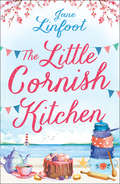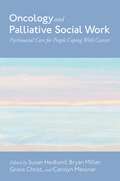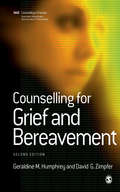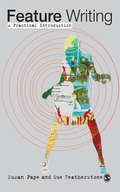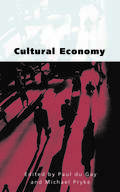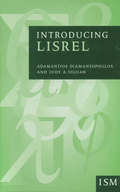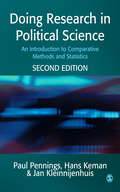- Table View
- List View
Handbook of Agricultural Biotechnology, Volume 5: Nanobiofertilizers (Handbook of Agricultural Bionanobiotechnology)
by Chukwuebuka Egbuna Charles Oluwaseun Adetunji Anton Ficai Oluwatosin Ademola IjabadeniyiThis book details recent advances in the applications of nanobiofertilizers as a substitute for synthetic fertilizers in boosting food production. With the steady rise of the world’s population, there is a need to increase the production of safe and nutritious food. The constant loss of arable land, as a result of various anthropogenic activities from human action, has become a threat to global biodiversity and ecosystems. Additionally, the issue of climate change has imposed many obstacles to increasing agricultural productivity, especially from biotic and abiotic stressors and temperature-limited environments, such as in high altitudes or seasonally hot regions. Because of these factors, there is a need to adopt sustainable and modern technologies that can boost and improve the rate of food production. One of the cheapest means of enhancing sustainable food production is to explore natural and unlimited beneficial microorganisms, particularly those that can increase the level of soil fertility, improve crop production and health, improve tolerance to stress, support nutrient uptake and availability, and boost natural biodiversity. The synergetic effect of nanotechnology and beneficial microorganisms for the effective bio-fabrication of nanobiofertilizers, is a sustainable solution for producing pesticide-free food. This book provides a deep insight into microbial diversity, recent techniques used for the isolation, screening, and characterization of beneficial microorganisms with eco-friendly attributes, used for bioengineering of nanobiofertilizers, as well as the application of proteomics, metabolomics, genomics, and bioinformatics. The book also covers commercialization, patents, and the business and socio-economic aspects of nanobiofertilizers, as well as the role of policymakers, stakeholders, and government agencies in the translation of nanobioferilizer research into policy. Audience The book is a useful resource for a diverse audience, including industrialists, food industry professionals, agriculturists, agricultural microbiologists, plant pathologists, botanists, microbiologists, biotechnologists, nanotechnologists, microbial biotechnologists, farmers, policymakers, and extension workers.
Narratives of Arab Secularism: Politics, Feminism and Religion (Routledge Studies in Middle Eastern Democratization and Government)
by Youssef M. ChoueiriThis book offers a new interpretation of the rich narratives of Arab secularism, contending that secularism as a set of ideas and a social movement is destined to loom large on the political and legal horizon of most Arab states.Youssef M. Choueiri provides a study of three moments in the development of secularism in the Arab World, the Machiavellian, the Alfierian and the Gramscian. It is within such a scope that secularism in its interaction with state-building projects, women’s emancipation and religion is treated as an intellectual current and a discursive entity embedded in the political process of its diverse societies. Through the chapters, Choueiri demonstrates how secularism occupies a pivotal presence in the religious and political life of the Arab world, exploring such interrelated configurations as indigenous contributions, diverse reforms and the impact of Western states. He concludes that secularism has become a moral prerequisite and a required vehicle in creating the necessary conditions for the success of democracy in the Middle East.Narratives of Arab Secularism tackles the complexity and contemporary ramifications of the subject in a way that no previous single study has been able to. It will be relevant to both students and academics dealing with topics related to the Middle East including religion, politics, anthropology and history.Chapter 6 of this book is freely available as a downloadable Open Access PDF at http://www.taylorfrancis.com under a Creative Commons Attribution-Non Commercial-No Derivatives (CC-BY-NC-ND) 4.0 license.
Italian Renaissance Art
by Laurie Schneider Adams"The chronology of the Italian Renaissance, its character, and context have long been a topic of discussion among scholars. Some date its beginnings to the fourteenthcentury work of Giotto, others to the generation of Masaccio, Brunelleschi, and Donatello that fl ourished from around 1400. The close of the Renaissance has also proved elusive. Mannerism, for example, is variously considered to be an independent (but subsidiary) late aspect of Renaissance style or a distinct style in its own right."
Scottish Gaelic: A Comprehensive Grammar (ISSN)
by William LambScottish Gaelic: A Comprehensive Grammar is a definitive description of contemporary Gaelic.The volume presents an authoritative account of modern Gaelic grammar, attending to both idealised usages – as typically taught in formal education – and more colloquial forms. Core chapters include useful observations about dialectal and register differences, such as variations in inflection, pronunciation and word forms. The book also demystifies nuances of the language that many users find opaque, according to recent research. In each chapter, the most important, basic information is presented first (e.g. standard verb conjugations), followed by increasingly detailed information for more advanced users. This way, the book addresses the diverse needs of its intended audience. Brimming with authentic examples, the volume accommodates readers of all levels, from complete beginners to professional linguists. It is both an ideal textbook for structured coursework and an indispensable companion for independent study.
Interpersonal Positioning in English as a Lingua Franca Interactions (Routledge Research in Language and Communication)
by Svitlana Klötzl Birgit SwobodaThis book offers a critical reflection on interpersonal positioning across both large- and small-scale contexts and highlights the multi-faceted nature of intercultural communication in today’s global world. The volume establishes positioning primarily as the negotiation of interpersonal relationships, and draws on concepts from across disciplines by way of reappraisal before applying them to two specific domains: MMORPGs (Massively Multiplayer Online Role-Playing Games) and private ELF couple interaction. While acknowledging and showcasing the unique features of positioning in these two contexts, Klötzl and Swoboda point to their commonalities by looking at how language and specifically English is used as a communicative resource in lingua franca situations. The book also identifies new directions for future methodological innovations in that it demonstrates how the same interaction can be looked at in methodologically-different ways and how the authors’ own positions projected on to such interaction create an integrated tri-partite perspective on the two domains. Shedding light on interpersonal positioning in different contexts and in turn on global communication more generally, this book will be of particular interest to students and researchers in discourse analysis, pragmatics, computer-mediated communication, sociolinguistics, and applied linguistics.
Sensitivity Analysis for Business, Technology, and Policymaking: Made Easy with Simulation Decomposition (SimDec) (Routledge Open Business and Economics)
by Mariia Kozlova Julian Scott YeomansSimDec is a revolution in decision-making support. SimDec “teases out” inherent cause-and-effect relationships and reveals the intricacy of relationships between sets of input and output variables. At its core, SimDec is an amalgamation of uncertainty and global sensitivity analysis with an innovative visualization technique. While straightforward and elegant, this novel approach significantly enhances the analytical capabilities of users by readily exposing seemingly, a priori, counterintuitive behaviours so that they can be readily understood by both technical specialists and non-technical users alike.This book is the first to articulate the ubiquitous applicability of SimDec and has been written by the leading proponents of the technique. The book provides the necessary background to fully understand the underlying approach and then demonstrates its applicability to a wide spectrum of fields, such as finance, entrepreneurship, energy, 3D manufacturing, geology, the environment, engineering, public policy, and even superconducting magnets. To facilitate as widespread adoption and penetration of SimDec as possible, all supporting computer codes are available, open-source, in Python, Julia, R, and Matlab.The innovative material will be of primary benefit to practitioners and researchers analyzing data from the social sciences, business, science, engineering, mathematics, and computing.The Open Access version of this book, available at http://www.taylorfrancis.com, has been made available under a Creative Commons [Attribution-Non Commercial-No Derivatives (CC-BY-NC-ND)] 4.0 license.
Something to be Proud Of
by Anna Zoe QuirkeImogen Quinn is a chaotic bisexual with dreams of becoming a stand-up comedian, crushing stereotypes about autistic people. When she decides to put on a pride festival that's accessible for everyone, she enlists the help of the openly gay captain of the football team, Ollie Armstrong. Dealing with the fallout from his parents' divorce, Ollie is initially hesitant. But it doesn't take long for him to be swept up by Imogen's passion, and he's not the only one. Joined by the (infuriatingly perfect) head girl, musicians, an artist and a star baker – a dream team soon assembles to help plan pride and tackle injustices in their school and beyond. You'd better listen out – they're getting ready to make some noise. Packed full of fun, forever friendships and fighting back, this YA debut is perfect for fans of I Kissed Shara Wheeler, Gwen and Art are Not in Love, Feel Good, Heartstopper and Not My Problem.
The Little Cornish Kitchen (The Little Cornish Kitchen #1)
by null Jane LinfootSt Aidan: a cosy Cornish village where friendships are made for life and it’s always cocktail hour somewhere… ‘Beautifully crafted and wrapped in romance’ Heidi Swain It's time to come home to Cornwall With an exiting new life in Paris, Clemmie Hamilton isn't looking forward to heading home to the picturesque but sleepy village of St Aidan, Cornwall. However, when she discovers that the cosy apartment by the sea, which her grandmother left to her, is under threat from neighbour and property developer, Charlie Hobson, Clemmie realises she can't abandon her home in its time of need. With her childhood friends encouraging her, Clemmie decides to turn the apartment into 'The Little Cornish Kitchen' – a boutique pop up pudding club raising money for the repairs to the building in an effort to stop Charlie once and for all. But when Charlie and his easy charm won't seem to go away, everything soon becomes even messier than the state of Clemmie's Cornish kitchen… Why readers love The Little Cornish Kitchen: ‘Have you ever liked a book so much that you wanted to give it a hug…chicklit GOLD’ Pretty Little Book Reviews ‘Jane Linfoot combines fabulous friendship with gorgeous true love…a fantastic captivating story with a sweet romantic ending’ With Love for Books ‘A character that you genuinely like’ Mrs Wheddon Reviews ‘The perfect holiday read…you feel as if you are part of the group friends’ Coffee and Kindle Book Reviews ‘Where should I begin with this wonderful, delicious novel...a stunning, fabulous read’ Kat, Goodreads ‘An uplifting, warm and romantic story that was a real pleasure to read’ Rae Reads
Strategy: Theory, Practice, Implementation
by David Mackay Mikko Arevuo Maureen MeadowsWhat does strategy mean to the founder and CEO of a coaching and consulting company whose mission is to create inclusive and values-driven cultures where people can achieve their full potential while positively impacting society? How is sustainable strategic decision-making viewed by a former Member of the European Parliament? Developed in consultation with lecturers, students, and professionals, the research-driven process-practice model of strategy in Strategy: Theory, Practice, Implementation places implementation at its core, enabling students to develop a crystal-clear understanding of how strategy operates in a culture of dynamism, adaptability, and change. The authors' wealth of teaching, research, and practitioner experience shines through in their writing as they strike the perfect balance between clarity and rigour. They expertly cover all the core areas of strategy, using carefully paced, step-by-step guidance to apply theories and models of strategy to a diverse range of examples, making the text the most practical of its kind. Moving beyond the limits of traditional texts, Strategy offers unique Practitioner Insights (and accompanying video interviews) gathered from professionals engaged in a range of strategic roles, across multiple industries and sectors worldwide, to help students grasp the complex reality of strategic management in practice. Strategy ultimately provides students with an empowering, critical, and highly practical approach to thinking, talking, and acting like a strategist. Online resources accompanying the textbook include: For registered adopters: - A test bank - PowerPoint slides - Answers to, or guidance on, the case study questions in the book - A series of 'Boardroom Challenges' for use in group role play exercises / action learning simulations - Teaching notes on using the 'Boardroom Challenges' in class For students: - Practitioner insight video interviews, and further videos providing advice on how students can enhance their employability - Research Insights to broaden students' perspectives of academic research and its impact on strategic thinking - Links to articles, cases, chapters, or multimedia resources to support students' further reading - Additional case studies with exercises or discussion questions - MCQs - Guidance on how to analyse a case study - Flashcard glossary - Two additional chapters: Chapter 15 Designing effective strategy activities; Chapter 16 Strategy in practice: learning, reflecting, thinking
Second-Class Saints: Black Mormons and the Struggle for Racial Equality
by Matthew L. HarrisAn in-depth account--grounded in new archival discoveries--of the most consequential development in Mormon history since the end of polygamy On June 9, 1978, the phones at the headquarters of the Church of Jesus Christ of Latter-day Saints (LDS) were ringing nonstop. Word began to spread that a momentous change in church policy had been announced and everyone wanted to know: was it true? The answer would have profound implications for the church and American society more broadly. On that historic day, LDS church president Spencer W. Kimball announced a revelation lifting the church's 126-year-old ban barring Black people from the priesthood and Mormon temples. It was the most significant change in LDS doctrine since the end of polygamy almost 100 years earlier. Drawing on never-before-seen private papers of LDS apostles and church presidents, including Spencer W. Kimball, Matthew L. Harris probes the plot twists and turns, the near-misses and paths not taken, of this incredible story. While the notion that Kimball received a revelation might imply a sudden command from God, Harris shows that a variety of factors motivated Kimball and other church leaders to reconsider the ban, including the civil rights movement, which placed LDS racial policies and practices under a glaring spotlight, perceptions of racism that dogged the church and its leaders, and Kimball's own growing sense that the ban was morally wrong. Harris also shows that the lifting of the ban was hardly a panacea. The church's failure to confront and condemn its racial theology in the decades after the 1978 revelation stifled their efforts to reach Black communities and made Black members the target of racism in LDS meetinghouses. Vigilant members pestered church leaders to repudiate their anti-Black theology, forcing them to live up to the creed in Mormon scripture that "all are alike unto God." Deeply informed, engagingly written, and grounded in deep archival research, Harris provides a compelling and detailed account of how Mormon leaders lifted the priesthood and temple ban, then came to reckon with the church's controversial racial heritage.
Everything You Have Told Me Is True: The Many Faces of Al Shabaab
by Mary HarperThe East African group Al Shabaab is one of the century's most successful violent jihadist movements. Now over a decade old, its staying power has defied local and international efforts to destroy it, including US drone attacks and an African Union force. It also has governing power, ruling over millions of Somalis and vast swathes of territory, and physical power, committing spectacular acts of violence. But what lies behind the headlines and the bloodshed? Who are Al Shabaab and why do people join? How does this organization govern, educate and indoctrinate? How does it operate such successful financial, communications and intelligence networks? BBC Africa Editor Mary Harper has reported on Somalia for twenty-five years. She has gained extraordinary access to members of Al Shabaab-and they in turn have intruded unsettlingly into her life. Travelling throughout the region, she speaks to ordinary people with daily experience of Al Shabaab. Some have suffered tremendous loss or made unbearable compromises; others have benefited, often in unexpected ways. Harper's account is a must-read for anyone looking to get under the skin of violent jihadists, those who report on them, and those who must live in their shadow.
Oncology and Palliative Social Work: Psychosocial Care for People Coping With Cancer
by Susan Hedlund, Bryan Miller, Grace Christ, and Carolyn MessnerOncology and Palliative Social Work: Psychosocial Care for People Coping with Cancer illustrates the need for integrating early palliative care for patients with cancer and the important role social workers have in providing psychosocial support services across the cancer trajectory. There is a convergence of oncology and palliative social work specialties in the delivery of comprehensive, culturally-congruent, whole person cancer care. OPSW reflects the collective knowledge, skills, clinical experience and perspectives of a diverse group of interprofessional contributors, including best practices, emerging trends, and priorities in psychosocial oncology, and the impact of the COVID-19 pandemic on this evolving landscape. The volume is divided into four sections, each with five to eight thematically connected chapters. Topics include: diagnosing and treating cancer; equity, racism, cultural competence, and cultural humility; social determinants of health; cancer care amid pandemics, disasters and other traumatic events; survivorship, integrative programs, lifestyle and rehabilitation; innovative models in palliative care in oncology; the future direction of psychosocial oncology and palliative care, including research; psychosocial aspects of cancer; pain, symptom, and side effect management; a novel collaborative care model for people living with serious mental illness; interprofessional spiritual care; informal cancer caregivers; palliative and hospice care at the end of life; loss, grief, and bereavement; underrepresented, underserved, and vulnerable populations; ethical and legal issues; professional development and sustainability; credentialing, certification, and continuing education; technology; social work leadership skills; interprofessional practice; international oncology and palliative social work; and, strategies for guiding best practices for the future.
Digital Empires: The Global Battle to Regulate Technology
by Anu BradfordFinancial Times Best Books of 2023 in Economics The global battle among the three dominant digital powers—the United States, China, and the European Union—is intensifying. All three regimes are racing to regulate tech companies, with each advancing a competing vision for the digital economy while attempting to expand its sphere of influence in the digital world. In Digital Empires, her provocative follow-up to The Brussels Effect, Anu Bradford explores a rivalry that will shape the world in the decades to come. Across the globe, people dependent on digital technologies have become increasingly alarmed that their rapid adoption and transformation have ushered in an exceedingly concentrated economy where a few powerful companies control vast economic wealth and political power, undermine data privacy, and widen the gap between economic winners and losers. In response, world leaders are variously embracing the idea of reining in the most dominant tech companies. Bradford examines three competing regulatory approaches—the American market-driven model, the Chinese state-driven model, and the European rights-driven regulatory model—and discusses how governments and tech companies navigate the inevitable conflicts that arise when these regulatory approaches collide in the international domain. Which digital empire will prevail in the contest for global influence remains an open question, yet their contrasting strategies are increasingly clear. Digital societies are at an inflection point. In the midst of these unfolding regulatory battles, governments, tech companies, and digital citizens are making important choices that will shape the future ethos of the digital society. Digital Empires lays bare the choices we face as societies and individuals, explains the forces that shape those choices, and illuminates the immense stakes involved for everyone who uses digital technologies.
Counselling for Grief and Bereavement (Therapy in Practice)
by Geraldine M Humphrey David Zimpfer`The authors have done their homework in reading and consulting with the prominent literature, especially regarding children. All this effort gives the book a solid background foundation and makes it readable, and well-usable, for both lay counsellors and professional providers, and for all of us who are engaged in the delicate and rewarding endeavor of Grief Therapy′ - Naji Abi-Hashem, Clinical & Cultural Psychologist, Berkeley, California Praise for the First Edition: `The book provides an absorbing and challenging journey through the possible process involved in bereavement work, and encourages one to think broadly about how one can approach a bereaved person... this was a book I enjoyed reading very much, and which I found both theoretically sound and practically helpful′ - Bereavement Care (Cruse) Counselling for Grief and Bereavement, Second Edition is a bestselling, introductory guide for professionals who work with people experiencing bereavement through death and other forms of loss. Focusing on practical assessment and intervention strategies, Geraldine Humphrey and David Zimpfer guide readers through the essential theory and skills needed to work with clients in a way which sensitively facilitates the process of grief, initiates healing and promotes a sense of growth. Setting out the broad principles for practice, the authors go on to show how these can be applied in working with individuals, families and groups and in relation to specific issues including chronic and life-threatening illnesses, palliative care and complicated grief. Carefully chosen case examples illustrate the counselling process, while specific attention is paid throughout to ethical considerations and the possible need for referral. This fully revised and updated Second Edition features a new chapter on working with children and adolescents: both from the perspective of young people who are grieving losses and those who are receiving palliative care as patients. While focusing on the practical, the book provides a firm theoretical base by explaining key concepts such as attachment, grief and resilience. Geraldine M. Humphrey is Counsellor in the Department of Psychology at the North Canton Medical Foundation, specializing in death, illnesses, and non-death and grief. David G. Zimpfer is former Director of the Cancer Center of Ohio.
Feature Writing: A Practical Introduction
by Susan Featherstone Susan PapeThis book provides a practical and richly informative introduction to feature writing and the broader context in which features journalists operate. As well as covering the key elements and distinctive features that constitute good feature writing, the book also offers a rich resource of real life examples, case studies and exercises. The authors have drawn on their considerable shared experience to provide a solid and engaging grounding in the principles and practice of feature writing. The textbook will explore the possibilities of feature writing, including essential basics, such as: Why journalists become feature writers The difference between news stories and features What features need to contain How to write features The different types of features The text is intended for both those who are studying the media at degree level and those who are wishing to embark on a career in the print industry. It will be invaluable for trainee feature writers.
Cultural Economy: Cultural Analysis and Commercial Life (Culture, Representation and Identity series)
by Paul du Gay and Michael PrykePhrases such as `corporate culture′, `market culture′ and the `knowledge economy′, have now become familiar clarion calls in the world of work. They are calls that have echoed through organizations and markets. Clearly something is happening to the ways markets and organizations are being represented and intervened in and this signals a need to reassess their very constitution. In particular, the once clean divide that placed the economy, dealt with mainly by economists, on one side, and culture, addressed chiefly by those in anthropology, sociology and the other `cultural sciences′, on the other, can no longer hold. This volume presents the work of an international group of academics from a range of disciplines including sociology, media and cultural studies, social anthropology and geography, all of whom are involved not only in thinking `culture′ into the economy but thinking culture and economy together.
Developing Language and Literacy with Young Children (Zero to Eight)
by Marian R Whitehead`In its third edition...the author has included the latest research evidence relating to children aged from nought to eight. Her writing embraces the value of play, relationships, bilingualism and multilingualism in creating a rich language and literacy environment. Developing Language and Literacy with Young Children will appeal to a wide range of readers - practitioners, students, and their tutors, as well as parents and carers′ - Early Years Update ′Highly readable... Anybody working with babies and young children needs to have the knowledge that Whitehead clearly explains here′ - SureStart ′One of the many excellent features of this book is the way it tackles the issue of bilingualism in early childhood′ - Early Years Educator (eye) Praise for previous editions: `Marian Whitehead forces the reader to attend to the "voice of the child against the encroachment of inappropriate curriculum demands. Her total fascination for children′s language development captures the reader in an enthusiastic and informed voyage through "the most exciting and important aspect of human development - language in the early years′ - Early Years `This is an excellent read for all parents and workers with young children. The style of the book is friendly and accessible, with beautifully produced of photographs of children and indeed of their own work. Marian Whitehead is not ashamed to draw on her experiences as a grandparent, as well as highly competent theoretical researcher; she does both with competence and humour. This will prove an excellent source book for those involved in course design from childminders to university lecturers′ - Child Language Teaching and Therapy Looking at the most exciting and important aspect of human development - communication and language in the early years - this accessible book gives carers, parents, teachers and other professionals who work and play with young children a confident understanding of children′s communication and language development in the years from birth to age eight. The book examines the wide range of elements that are typical of all our communication and language activities: thinking, feeling, imagining, talking, listening, drawing, writing and reading. The author emphasizes the importance of children′s relationships and communications with the people who care about them, spend time with them and share in the excitement of their developing languages and their investigations of literacy. Taking a holistic approach, she covers: o early communication and language o the achievements of young bilinguals o the significance of stories, narrative and language play o the emergence of literacy in homes, early years settings and classrooms. ′This highly readable guide discusses how to help babies become competent communicators...Anybody working with babies and young children needs to have the knowledge that Whitehead clearly explains here′ - SureStart
Introducing LISREL: A Guide for the Uninitiated (Introducing Statistical Methods series)
by Judy A Siguaw Adamantios Diamantopoulos`If you encounter a research student for whom the very word LISREL induces feelings of fear, quietly recommend that they read this book. They will thank you for it. With increasingly user-friendly versions of LISREL being released and guide books such as this published, LISREL really should be accessible to all′ - European Journal of Marketing Emphasizing substantive issues rather than intricate statistical details, this book provides a comprehensive introduction to LISREL for structural equation modeling (SEM) using a non-technical, user-oriented approach that. The emphasis is on: - exposing the reader to the major steps associated with the formulation and testing of a model under the LISREL framework - describing the key decisions associated with each step - highlighting potential problems and limitations associated with LISREL modeling - assisting the interpretation of LISREL input and output files. The overall aim is to provide a critical understanding of what is really involved in LISREL modeling and sensitize the reader against `mechanically′ fitting or modifying models. The entire range of decisions associated with the practical application of the LISREL program is covered in a user-friendly fashion. Concrete examples are used throughout to illustrate issues relating to model conceptualization, specification, identification, estimation, evaluation, modification, and cross-validation and illustrated with actual program output. The program is made much more accessible by adopting the more user-friendly SIMPLIS command language for preparing input files. Although primarily aimed at beginning users, readers are directed to further reading together with a comprehensive bibliography for the more advanced user.
Using Narrative in Social Research: Qualitative and Quantitative Approaches
by Jane Elliott′Jane Elliott′s examination of the use of "narrative" within the broad context of social science inquiry is a must-read for both qualitative and quantitative researchers, novice and expert alike′ - Journal of Advanced Nursing `This important book does an impressive job of synthesising a complex literature and bringing together both qualitative and quantitative methods of narrative analysis. It will become a milestone in the development of narrative methods. Although ground-breaking in many ways, it is very clearly written and accessible to readers from a wide variety of backgrounds and methodological experience′ - Nigel Gilbert, University of Surrey `An elegantly written, scholarly and accessible text. Jane Elliott shows a sophisticated appreciation of contemporary methodological developments, and makes a persuasive case for the use of narrative approaches in both qualitative and quantitative research. The book challenges and advances debates about combining methods, and shows how stories can work within and across conventional research boundaries. It is a truly original contribution to the literature′ - Amanda Coffey, Cardiff School of Social Sciences `An outstanding book. Jane Elliott breaks new ground by demonstrating to new generations of social scientists how the power of narrative can fruitfully be harnessed in social research. This is a "must read" book′ - Professor Mike Savage, University of Manchester This is a lucid and accessible introduction to narrative methods in social research. It is also an important book about the nature, role and theoretical basis of research methodology in general. Jane Elliott instructs the reader on the basic methods and methodological assumptions that form the basis of narrative methods. She does so in a way that is practical and accessible and in a way that will make the book a favourite with students and experienced researchers alike. Elliott argues that both qualitative and quantitative methods are characterised by a concern with narrative, and that our research data can best be analyzed if it is seen in narrative terms. In concrete, step-by-step terms she details for the reader how to go about collecting data and how to subject that data to narrative analysis, while at the same time placing this process in its wider theoretical context. She works across the traditional quantitative/qualitative divide to set out the ways in which narrative researchers can uncover such issues as social change, causality and social identity. She also shows how the techniques and skills used by qualitative researchers can be deployed when doing quantitative research and, similarly, how qualitative researchers can sometimes profit from using quantitative skills and techniques. "This book provides both a fascinating and a challenging read. What sets this text apart from other books on research methodology and methods is that it does not focus exclusively on either quantitative or qualitative research approaches, but rather attempts to bridge the divide. The book should be compulsory reading not only for those aspiring to undertake narrative research and those students undertaking higher degree research courses, but also for those more experienced researches wishing to explore contemporary issues in research methods and methodology. As a recent recruit to a lecturer-practitioner post with little recnt experience in the subject area covered by this book, i found it met my needs very well. I would certainly recomment this book for purchase." Dr Andrew Pettipher, University of Nottingham, UK.
Arms Control: The New Guide to Negotiations and Agreements with New CD-ROM Supplement (Routledge Library Editions: Cold War Security Studies #5)
by Jozef Goldblat`A unique and indispensible work that serves both as a basic introduction to the disarmament scene and a reference book for experts′ - Disarmament Times `This compendium of the history and achievements of arms control and disarmament efforts is unique in its kind and is likely to remain so. This for three reasons: first, because of its unparalleled comprehensiveness; second, because of the outstanding quality of its presentation, and, third, because of its author, Jozef Goldblat, one of the world′s leading experts in the field. This triad makes the updated Second Edition of Arms Control: The New Guide to Negotiations and Agreements a must for all concerned with international security in general and arms control in particular′ - Curt Gasteyger, Graduate Institute of International Studies, Geneva `The thesaurus of arms regulation and disarmament...a precious tool for negotiators and treaty makers′ - Ambassador V Petrovsky, Former Secretary-General of the Conference on Disarmament `Being the most comprehensive and authoritative compilation and analysis of arms control agreements available, this is an indispensable reference volume for students and practitioners of arms control and international security. The author has spent a lifetime in the study and practice of international security affairs: where international law and arms control agreements are concerned, there is no one better qualified than him′ - Sverre Lodgaard, Norwegian Institute of International Affairs, Oslo The revised and updated edition of Arms Control: The New Guide to Negotiations and Agreements contains the most authoritative and comprehensive survey ever published of the documents related to arms control. All major agreements reached since the second half of the nineteenth century through to mid-2002 are critically analysed and assessed. The assessment is made in the light of the international security environment, the developments in the field of weapon technology, the threat of nuclear, chemical and biological weapons proliferation, and the efforts to strengthen the humanitarian law of armed conflict. The accompanying CD-ROM reproduces full text and carefully selected excerpts of treaties, conventions, common understandings, statutes, charters, binding decisions of international bodies, final acts of international conferences, exchanges of letters and diplomatic notes. Multilateral agreements are followed by a list of parties. Enriched with new maps, tables and figures, as well as an expanded glossary and bibliography, the book will remain the definitive resource for students of international relations, journalists, diplomats and military strategists. Jozef Goldblat, the author, is Vice-President of the Geneva International Peace Research Institute (GIPRI), Resident Senior Fellow of the UN Institute for Disarmament Research (UNIDIR) and Associate Editor of Security Dialogue, published by SAGE for the International Peace Research Institute, Oslo (PRIO). He has studied the problems of arms control since the 1950s and has been involved in arms control negotiations. From 1969 to 1989 he directed the arms control and disarmament programme of studies at the Stockholm International Peace Research Institute (SIPRI). He has lectured at various universities and has written reports, articles and books on the arms race and disarmament. His latest publications include The Nuclear Non-Proliferation Regime: Assessment and Prospects, The Hague Academy of International Law, 1997, and Nuclear Disarmament: Obstacles to Banishing the Bomb, I. B. Tauris, 2000.
Doing Research in Political Science: An Introduction to Comparative Methods and Statistics
by Hans Keman Paul Pennings Jan KleinnijenhuisThis is an immensely helpful book for students starting their own research… an excellent introduction to the comparative method giving an authoritative overview over the research process - Klaus Armingeon, University of Bern Doing Research in Political Science is the book for mastering the comparative method in all the social sciences - Jan-Erik Lane, University of Geneva This book has established itself as a concise and well-readable text on comparative methods and statistics in political science I…strongly recommend it. - Dirk Berg-Schlosser, Philipps-University Marburg This thoroughly revised edition of the popular textbook offers an accessible but comprehensive introduction to comparative research methods and statistics for students of political science. Clearly organized around three parts, the text introduces the main theories and methodologies used in the discipline. Part 1 frames the comparative approach within the methodological framework of the political and social sciences. Part 2 introduces basic descriptive and inferential statistical methods as well as more advanced multivariate methods used in quantitative political analysis. Part 3 applies the methods and techniques of Parts 1 & 2 to research questions drawn from contemporary themes and issues in political science. Incorporating practice exercises, ideas for further reading and summary questions throughout, Doing Research in Political Science provides an invaluable step-by-step guide for students and researchers in political science, comparative politics and empirical political analysis.
Counselling for Stress Problems (Therapy in Practice)
by Windy Dryden Stephen PalmerSeminars by Professor Windy Dryden. See the man live and in action. To find out more and to book your place go to www.cityminds.com _______________________________________ `A welcome addition to the series. The co-authors... have endeavoured to give a thorough and practical guide to this vast subject and they have managed to do this within the confines of an easy-to-read, cheap and relatively short paperback... a very useful practical volume for the general counsellor to have on their book shelf′ - Counselling, The Journal of the British Association for Counselling and Psychotherapy This comprehensive guide views stress counselling and management from a multimodal perspective. Clear guidelines show practitioners how they can give their clients the most effective help for their stress problems using a technically eclectic and systematic approach. The authors discuss the symptoms and causes of stress and outline a framework in which stress problems can be understood. They emphasize the importance of assessment as a guide to the selection of multimodal interventions and of tailoring the counselling approach for each client. Chapters discuss the range of interventions that can be used - cognitive, imagery, behavioural, sensory, interpersonal and health/lifestyle - and the most useful techniques that can be employed within these models, such as disputing irrational beliefs, coping imagery, psychodrama, relaxation training and assertion training. Case examples illustrate commonly used techniques.
Understanding and Using Advanced Statistics: A Practical Guide for Students
by Christian Yavorsky Emma Barkus Jeremy J FosterUnderstanding and Using Advanced Statistics is a comprehensive, practical guide for postgraduate students advising how and when to use more advanced statistical methods. Perfect for students without a mathematical background, the authors refresh important basics such as descriptive statistics and research design as well as introducing essential upper-level techniques to cater for the advanced student. Key Features: - Comprehensive guide informing how to use a range of advanced statistical methods such as MANOVA, path analysis and logistical regression; - Inter-disciplinary: ideal for students studying upper level statistical methods in any subject across the social sciences; - Practical guide: case studies, further reading, key terms explained in order to help the non-mathematically orientated student get ahead with their research. Building on undergraduate statistical grounding, Understanding and Using Advanced Statistics provides the upper-level researcher with the knowledge of what advanced statistics do, how they should be used, and what their output means.
Evidence-Based Policy: A Realist Perspective
by Ray PawsonIn this important new book, Ray Pawson examines the recent spread of evidence-based policy making across the Western world. Few major public initiatives are mounted these days in the absence of a sustained attempt to evaluate them. Programmes are tried, tried and tried again and researched, researched and researched again. And yet it is often difficult to know which interventions, and which inquiries, will withstand the test of time. The evident solution, going by the name of evidence-based policy, is to take the longer view. Rather than relying on one-off studies, it is wiser to look to the ′weight of evidence′. Accordingly, it is now widely agreed the most useful data to support policy decisions will be culled from systematic reviews of all the existing research in particular policy domains. This is the consensual starting point for Ray Pawson′s latest foray into the world of evaluative research. But this is social science after all and harmony prevails only in the first chapter. Thereafter, Pawson presents a devastating critique of the dominant approach to systematic review - namely the ′meta-analytic′ approach as sponsored by the Cochrane and Campbell collaborations. In its place is commended an approach that he terms ′realist synthesis′. On this vision, the real purpose of systematic review is better to understand programme theory, so that policies can be properly targeted and developed to counter an ever-changing landscape of social problems. The book will be essential reading for all those who loved (or loathed) the arguments developed in Realistic Evaluation (Sage, 1997). It offers a complete blueprint for research synthesis, supported by detailed illustrations and worked examples from across the policy waterfront. It will be of especial interest to policy-makers, practitioners, researchers and students working in health, education, employment, social care, criminal justice, regeneration and welfare.
Virtual Ethnography
by Christine M HineCutting though the exaggerated and fanciful beliefs about the new possibilities of `net life′, Hine produces a distinctive understanding of the significance of the Internet and addresses such questions as: what challenges do the new technologies of communication pose for research methods? Does the Internet force us to rethink traditional categories of `culture′ and `society′? In this compelling and thoughtful book, Hine shows that the Internet is both a site for cultural formations and a cultural artefact which is shaped by people′s understandings and expectations. The Internet requires a new form of ethnography. The author considers the shape of this new ethnography and guides readers through its application in multiple settings.







